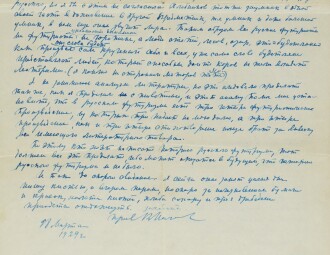Works by Kazimir Malevich at Sotheby's
Kazimir Malevich Biography
Most widely known as the founder of Suprematism – an artistic and philosophical mode that believes Art should transcend subject matter – Kazimir Malevich’s writing and painting transformed the art historical canon of the 20th century, and formed the basis for abstract art. Malevich was born in Ukraine in 1879 to Polish parents, and the family moved frequently in search of employment. Because of the family’s multiple relocations, he studied at a number of schools before moving to Moscow in 1904, where he began formal training at the Stroganov School of Applied Arts. Throughout his studies, Malevich was exposed to a wide array of movements and styles, including Impressionism and Post-Impressionism, Symbolism and Art Nouveau.
It was Malevich’s introduction to Expressionism and abstraction, namely through the work of Wassily Kandinsky and Mikhail Larionov, that caused his decided stylistic shift. He began reading literature on, and incorporating elements of, Cubism, Futurism and Primitivism. Works from this period of his career largely centered on everyday life, specifically scenes of peasantry. He also began experimenting with abstraction, culminating in his seminal work The Black Square of 1915, (which the New Yorker recently referred to as “the most famous, most enigmatic, and most frightening painting known to man.”).
His philosophically inspired artistic inquiries effectively peaked with the October Revolution in 1917 — of which he joined the People’s Commissariat for Enlightenment, working in the Department of Fine Arts. Over the next few years, Malevich would write his seminal text, O Novykh Sistemakh v Iskusstve (On New Systems in Art), which would mark the advent of Suprematism.
Although Malevich continued to work and teach his theories on art, including teaching alongside Marc Chagall in Vitebsk, Russia, the cultural state of Soviet Russia and the rise of government endorsed Social Realism relegated him to obscurity late in his career. The artistic repression he suffered under the new Russian regime culminated in the inclusion of his work in the 1932 state-sponsored exhibition of “degenerate art.” During his last years, he returned to genre painting, as he was banned from teaching or exhibiting within Russia. He died in Leningrad (today St. Petersburg) in 1935.
Despite the disappointing reception of his work in Russia during the later part of his life, his paintings nonetheless have inspired subsequent generations of artists—from fellow Russians such as El Lissitzky and Alexander Rodchenko to Minimalists later on.
Read Less












